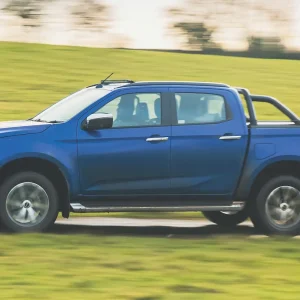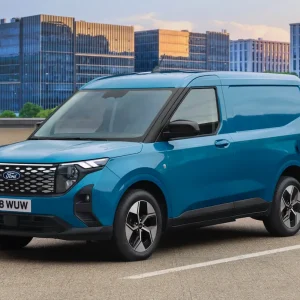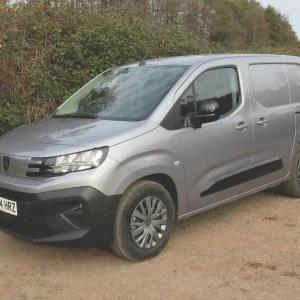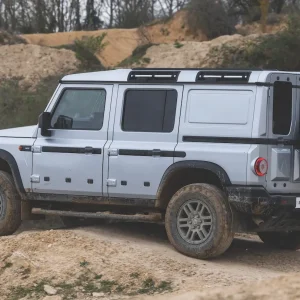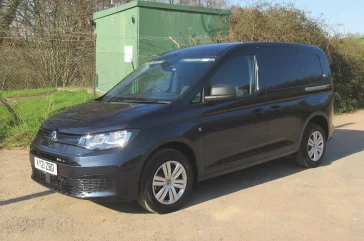
Question: What’s a Modular Transverse Matrix? Answer: It’s the platform that underpins most of Volkswagen’s cars, including the hugely successful Golf, and is used to support the latest Caddy.
Now in its fifth incarnation, and produced as a passenger carrier as well as in van guise, the newcomer features a restyled exterior. The changes to the interior include a new electronic handbrake as well as new driver assistance systems.
Also included is the availability of Travel Assist, which uses adaptive cruise control and lane keeping assistance to keep your VW centred in its motorway lane and at a safe distance from the traffic in front of you. It is a Level 2 Advanced Driver Assistance System (ADAS) and requires drivers to keep their hands on the wheel at all times.
On offer too is Trailer Assist, which helps you when you are trying to reverse with a trailer attached. VW has also developed a braking-when-turning function. It should stop you from accidentally driving into an oncoming vehicle’s path.
In van guise, Caddy is now known as the Caddy Cargo, while the long-wheelbase version is known as the Caddy Cargo Maxi.
Power comes courtesy of a trio of new 2.0l TDI diesels at 75hp, 102hp and 122hp, plus a 1.5l TSI turbocharged petrol engine at 114hp. It comes with Active Cylinder Technology as standard, which means that two of its four cylinders disengage when the vehicle is lightly-laden to save fuel.
A six-speed manual box comes as standard across the range, and both the petrol engine and the most powerful of the diesels can be specified with a seven-speed automatic dual-clutch Direct Shift Gearbox. The 122hp diesel can additionally be ordered with 4MOTION 4×4 drive.
There’s no electric version, but VW does, of course, have the somewhat larger all-electric ID Buzz Cargo in the pipeline for next year. Caddy is being marketed as a plug-in hybrid in mainland Europe, but there is no indication as to whether it will appear in the UK.
A new, rigid rear axle has been installed with a Panhard rod guided by trailing arms and coil springs replacing leaf springs. The aim is to improve the ride and save space without compromising the van’s carrying ability.
MacPherson-type struts help to support the front of the vehicle.
LED tail-lights are to be found on some models and VW is laying great stress on the newcomer’s connectivity.
An eSIM is fitted as standard and can summon help from the emergency services automatically if you are involved in a collision. It also means that the van can be linked to the driver’s smartphone under the We Connect banner – free-of-charge for the lifetime of the vehicle.
It includes a parking position finder, which guides you to wherever your Caddy has been left.
Free-of-charge for the first three years on all models with a sat nav, We Connect Plus delivers a range of features. They include an anti-theft warning system, which alerts you via your smartphone if somebody is trying to pinch your vehicle.
Boasting improved aerodynamics, which should translate into lower fuel consumption and CO2 emissions, the newcomer is longer, wider and lower in height than the old model, with a longer wheelbase. The load area’s internal height is nevertheless greater.
Maximum load width is up 57mm, to 1,613mm, while clearance between the rear wheel boxes is up 60mm, to 1,230mm. The rear door width is up by 51mm on models such as the one we tested, with twin rear doors, to 1,234mm.
While these improvements are warmly welcomed, a clear drawback is that the newcomer’s load area is smaller than its predecessor; 3.1m3 compared with 3.2m3. Cargo Maxi’s is down from 4.2m3 to 3.7m3. The shrinkage is modest in the first instance but much greater in the second, and we cannot help but view both reductions as retrograde steps.
Payload capacities range from 606kg to 700kg; below the ratings on offer from some of Caddy Cargo’s key rivals.
So far as the van is concerned the specification walk is Commerce, Commerce Plus and Commerce Pro. We opted for a Cargo in Commerce Plus trim with 122hp on tap.
Load bay
Access to the 3.1m3 load bay is afforded by a sliding nearside door plus asymmetric twin rear doors. The one on the offside is somewhat narrower than its companion.
Both back doors can be swung through 90º, and through 180º if you release the stays. Try as we might, we found it impossible to release the offside door’s stay.
Six cargo tie-down points are provided, and a full-height bulkhead separates the load area from the cab. It is made from hard plastic, presumably in a bid to save weight, and is doubtless pretty robust and able to ward off anything that comes hurtling forwards – but we’d much prefer a steel one.
Plastic mouldings and hardboard panels on the doors provide some protection against scrapes and dents inflicted during loading and unloading, but it is insufficient. The entire cargo area really needs timbering out, and the otherwise-unprotected floor should be defended with a tailored cover.
Interior and equipment
Sporting a smooth, uncluttered look, the fascia is dominated by a colour touch-screen.
In our case it was a 10in one which comes with the optional Discover Media DAB+ sat nav system.
The display also controls the air conditioning and the DAB radio. It is complemented by buttons, underneath which enable the driver and passenger to alter the climate settings independently of one another, and the radio to be turned up and down.
Remote controls for the radio are to be found on the reach- and height-adjustable leather-trimmed steering wheel. Complete with an armrest, the driver’s seat is height-adjustable too, the angle of the cushion can be changed and the lumbar support’s setting can be altered electrically.
Accompanied by a 12v power point, two USB sockets are positioned next to a large tray in front of the gearlever. You will find two more trays – one big, one small – plus a couple of cup-holders in the console between the seats.
Shelves sit on top of the dashboard, while items that need to be stowed out of sight can be popped into the roomy, lockable glove-box. Substantial bins in each of the cab doors can help to accommodate all the bits and pieces drivers have to haul around with them.Electric windows and electrically-adjustable exterior mirrors are included in the deal, and the doors can be locked and unlocked by pressing a button on the driver’s door.
Driver and passenger airbags are fitted, as is cruise control with a speed-limiter plus the new electronic parking brake aided by an Auto Hold button. It is there to stop the van rolling backwards if you take your foot off the brake pedal on an incline.
All the usual onboard safety systems are installed including ABS, Electronic Stabilisation Programme, Electronic Brakeforce Distribution, Brake Assist, Emergency Braking System and Traction Control System. Post-Collision Braking automatically applies the brakes after a smash should the driver be incapacitated, the idea being to minimise the danger of severe secondary impacts.
Reversing sensors are provided, as is an electronic diff lock.
Fitted too is Front Assist with Pedestrian Monitoring and City Emergency Braking System. It signals an alert and applies the brakes if the driver gets too close to the vehicle in front, and works in urban areas as well as on the motorway to ensure wayward cyclists do not get flattened.
Our Caddy sat on 16ins steel wheels garnished with plastic trims and shod with Hankook Ventus Prime 3 205/60 R16 tyres.
Powertrain
Caddy’s transversely-mounted in-line common rail direct-injection diesel comes with a variable turbine geometry turbocharger with an intercooler. Our demonstrator reached peak power across a 2750rpm-to-4250rpm plateau while maximum torque of 320Nm made its presence felt at from 1600rpm to 2500rpm.
Two SCR (Selective Catalytic Reduction) catalytic convertors are fitted, which translates into a double-dosing AdBlue system fed from a 15l reservoir – 6l bigger than the tank installed in the previous model.
The twin doses help to drive down emissions of harmful NOx (nitrogen oxide), which has the net effect of making the engine area cleaner.
Driving
Stability is one of Caddy Cargo’s key virtues. As you swing into a bend you experience next to zero body roll and the van remains determinedly on course, showing no inclination to break away.
The speed-related power steering clearly helps.
Using the Modular Transverse Matrix platform has undoubtedly benefited the ride. It is firm, but not uncomfortably so, and complements the handling nicely.
A slick gear change allows you to get the most out of the engine, which delivers a particularly impressive mid-range performance. However, undermining this long list of plus-points is a moderate amount of wind and tyre noise; the sole drawback in what is otherwise a positive driving experience.
Operating
The Caddy is warranted for three years and a generous 100,000 miles, with roadside assistance plus a paintwork warranty lasting for the duration.
The van is also covered against rusting through from the inside for 12 years. The servicing regime is flexible depending on the nature of the work the vehicle is on, with intervals capped at 18,600 miles or two years; whichever comes first.
The average official diesel consumption is 57.6mpg. We achieved marginally less at around 55mpg, with a start/stop system helping to keep fuel usage under control.
The regenerative braking system clearly helps too, recovering energy that would otherwise be wasted.
However, no spare wheel is provided, which is a negative so far as we are concerned even though it saves a bit of weight. You get an inflation kit and sealer instead, an arrangement that is well-nigh useless if you end up with a major gash in a tyre’s sidewall. Perhaps an oversight on the part of the designers. No side-rubbing strips are provided either, which means the metallic paint finish is vulnerable to damage; so do your best not to scratch it. It may seem an odd point to make, but Caddy has the most stylish-looking rear light clusters we have ever seen on a van. The rear light clusters look for all the world as though they were hand-designed by Scottish architect and design icon Charles Rennie Mackintosh – unlikely given that he died over 90 years ago.
Volkswagen Caddy Cargo Commerce Plus SWB 2.0 TDI 122hp 6sp manual
Price (ex VAT) £21,650
Price range (ex VAT) £18,365,-£27,545
Gross payload 648kg
Load length 1,797mm
Load width (min/max) 1,230/1,614mm
Load bay height 1,272mm
Load volume 3.1m3
Loading height 586mm
Rear door aperture 1,234mm x 1,122mm
Side door aperture 703mm x 1,096mm
Gross vehicle weight 2,220kg
Braked trailer towing weight 1,500kg
Residual value 33.36%
Cost per mile 39.51p
Engine size/power 1,968cc, 122hp @ 2,750-4,250rpm
Torque 320Nm @ 1,600-2,500rpm
Gearbox 6sp
Fuel economy 57.6mpg
Fuel tank 50l
CO2 127g/km
Warranty 3yrs/100,000 mls
Service intervals 2yrs/18,600 mls
Insurance group 33E
Price as tested £23,285
Options
Discover Media DAB+ sat nav system with 10ins colour touch-screen £1,120
Metallic paint £515
Rivals
Ford Transit Connect
Price (ex VAT) £16,730-£25,020
Load volume 2.9-3.6m3
Gross payload 679-959kg
Engines 100hp 1.0 petrol, 75hp, 100hp, 120hp 1.5 diesel
Verdict: Upgraded with an increased payload capacity, Connect still offers top-notch handling and performance. The manual box delivers a slick,
smooth gear-change, but don’t forget to check out the eight-speed automatic transmission. If you have to venture off-road then take a look at the Active variant, with higher ground clearance and an optional mechanical limited slip diff.
Peugeot Partner
Price (ex VAT) £17,855-£30,260
Load volume 3.3-3.8m3
Gross payload 721-1,009kg
Engines 102hp, 131hp 1.5 diesel, 100kW electric
Verdict: A dependable, well-put-together working tool, which is unlikely to disappoint, and the zero-emission electric model looks well worth investigating. Bear in mind that the same model is also marketed by Citroen as the Berlingo, by Vauxhall as the Combo and by Toyota as the Proace City.
Renault Kangoo/Kangoo Maxi
Price (ex VAT) £17,650-£29,400
Load volume 3.0-4.0m3
Gross payload 605-794kg
Engines 80hp, 95hp, 115hp 1.5 diesel, 44kW electric
Verdict: A new Kangoo has been announced and is scheduled to arrive on these shores in 2022. In the meantime we are concentrating on the existing model, whose virtues includie fuel-efficient diesel engines and a user-friendly gearbox. The electric Kangoo ETech looks set to play an increasingly-important role in the line-up. Hopefully we will see the version with the fuel cell range-extender go on sale too.
The Final Verdict
Design 8/10 – Safety is baked into this vehicle, an approach which can only be applauded
Cabin 8/10 – Comfortable working environment with plenty of storage space and connectivity
Ride 8/10 – Firm but not unpleasant. The MTM platform, axle and suspension have benefits
Refinement 7/10 – Quality standards were high apart from a dodgy rear door stay
Load area 6/10 – Smaller than on the previous model and payload capacity is below average
Handling/performance 8/10 – Both are to a high standard, with Caddy clinging on well through bends
Engine/transmission 8/10 – Well-matched, with ample power on tap and a slick gear change
Standard equipment 9/10 – As we observed above, the emphasis on safety wins Caddy high marks
Operating costs 8/10 – A solid approach to service intervals, fuel consumption should keep costs down
What Van? subjective rating 8/10 – Some drawbacks, but all-in-all an impressive package
Overall Rating = 79/100

